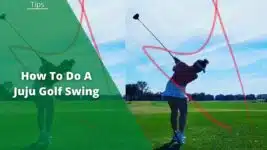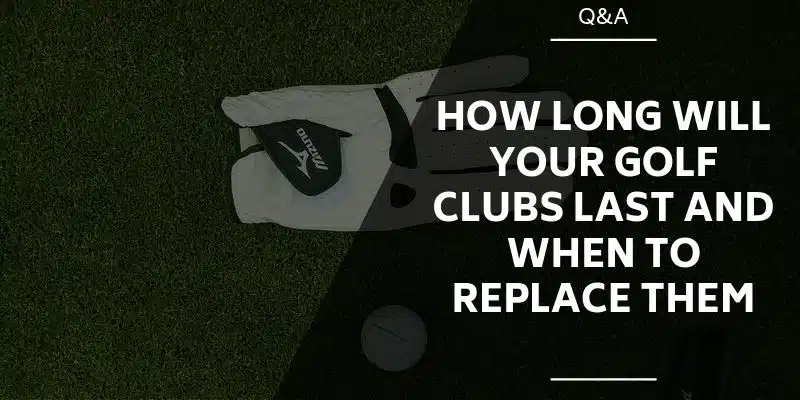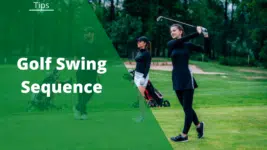When discussing swing paths in golf, a golfer’s target line is used as a baseline frame of reference. The golf club’s path on the downswing, through impact, and onto the release is classified in three ways.
- An inside-to-out path
- An outside-to-in path
- A straight-to-straight path (less common)
The most desirable swing path is an inside-to-out path.
So, what’s an inside out golf swing? An inside-to-out golf swing path is one where the club comes from the inside on the downswing, in relation to the target line, and moves to the outside of it. A slight inside-to-outside swing is the most desirable path for hitting consistently solid shots, so long as the face squares up by impact.
In this article, you’ll learn:
- What an inside to out golf swing path is
- How an inside to out path differs from other golf swing techniques
- Benefits of an inside to out golf swing path
- A step by step guide on how to achieve an inside out golf swing
- Practice drill to help develop an inside out swing
- Common mistakes to avoid with an inside to out swing path
Let’s dive in!
What Is an Inside To Out Golf Swing Path?

An inside-to-out swing path comes from the inside or left of the target line on the downswing. It squares up at the moment of impact. It moves slightly outside of the target line during the initial release. Lefties will flip this around.
As the body rotates and the arms release, the right forearm rolls over the top of the left (for right-handed golfers). The club’s path then moves back towards the target line and onto the inside of it once again. The swing will conclude with a well-balanced finish and the hands high.
Learn more: How To Shallow Golf Swing And Strike The Ball Cleaner
How an Inside-to-Out Path Differs from Other Golf Swing Techniques

The inside-to-outside swing path is often considered the most desirable path for the club to move on to hit consistently solid shots. But here’s how it differs from the other swing paths.
Outside to Inside Swing Path
An outside-to-inside swing path comes from the outside or right of the target line on the downswing. It squares up at the moment of impact. It then moves inside of the target line during the release.
A fade or slice is the most common result of the outside-to-inside swing path. This is because of having to hold the face more square, or even a touch open, and not letting it close through impact. The combination of the path and the face, in relation to the target line will cause a fade.
Square to Square Swing Path
A little less common swing path is the square-to-square path. This path, as the name suggests, is one where the path tries to stay more square and down the target line. The path is close to “zeroed out,” coming down, into impact, and on through the release.
This swing path requires a lot of manipulation in setup and with the swing itself. With this technique, it is highly recommended to have a slightly stronger grip. You will also want to move your hands forward at address to help keep the club face square.
This swing was made famous by the legendary Mo Norman. See the video below of Mo and his very recognizable swing.
Read more: How to Swing a Golf Club (Simple Step-by-Step Guide)
The Benefits of an Inside To Out Golf Swing Path

The big benefits of an inside-to-outside swing path include:
- Better control of your shots
- More consistency in your shot distribution
- Potential for a better impact position
- Potential for more distance
Better Control of Shots
With an inside-to-outside swing, you are more likely to keep your arms connected to the body throughout the swing. This means that you can have better control of what happens at impact. When you control the hand and club paths more, you are likelier to get the clubface into the ball squarely.
In addition, you will be much more likely to have good sequencing coming down from the top of your swing. This means the hips will be more likely to lead, followed by the upper body, then the hands and clubhead.
More Consistency in Shot Distribution
As pointed out above, the benefits of the inside-to-outside swing path are a more connected and better-sequenced swing. Not only does this lead to better control of your shots, but better consistency in your shot distribution as well.
This will help you hit more greens in regulation. It will also help you hit more shots from 100 yards closer to the flag.
Potential For a Better Impact Position
Having a good impact position is one of the most important factors in hitting solid, consistent, and long shots. A swing path coming from the inside and out is much more likely to get you into a strong impact position.
The Potential For More Distance
As pointed out, the in-to-out path leads to better ball striking. This means that you will have the ability to hit more shots on the center of the clubface. That is a positive in being able to hit it further.
Additionally, with being more connected to the body, you can unleash the power you built up in the backswing as you move down from the top. You are much more likely to be able to compress the ball at impact. That equals more distance.
Step-by-Step Guide to Achieve an Inside-to-Out Golf Swing Path
Here are steps to helping you achieve an inside-to-outside swing path.
- Use a neutral or slightly strong grip
- Use a relaxed, balanced, chest towards the ball, and hips back posture
- Align toes, knees, and hips, slightly right of parallel left to the target line
- Take the clubface back in line with the target line as the body rotates
- Rotate your hips 45 degrees and shoulders 90 degrees on backswing
- Lead hand flat or slightly bowed at top of swing, maintain through downswing and impact
- Use the proper downswing sequence, Hips→ Chest→ Hands→ Clubface→ Impact
Step #1- Use a Neutral or Slightly Strong Grip
A good neutral grip is the standard. This is one where the hands are working in tandem and not fighting one another. The V created with your thumb and pointer finger on both your right and left hand should be pointing over your trail shoulder. The trail shoulder for a right-handed golfer is your right. The trail shoulder for a left-handed golfer is the left.
You could even have a slightly stronger grip. This is where those V’s point more to the right of your right shoulder. You want to do this only slightly…towards the right side of your right shoulder.
Step #2- Use a Relaxed, Balanced, Chest Towards the Ball, and Hips Back Posture
Good posture means that you are relaxed and ready to move away from the ball athletically and powerfully.
To start, you bend slightly forward from your hips, about 30 degrees forward from standing vertically. Your chest towards the ball, and hips back. Your back is straight, from your tailbone to your head.
Your arms will hang down naturally from your shoulders. Your lead shoulder will be set slightly higher than your trail.
Step #3- Align Toes, Knees, and Hips, Slightly Right of Parallel Left to the Target Line
You generally want your toes, knees, hips, and shoulders to be parallel left of your target line. That is for a standard, straight shot. However, to help promote an inside-to-outside swing path, I suggest getting your lower body pointing just a shade right of that—not your shoulders, but your feet, knees, and hips.
This will help promote a path from the inside out on the downswing.
Step #4- Take the Clubface Back in Line With the Target Line as the Body Rotates
This tip is a big one! As the name, inside to outside implies, people think you need to take the club inside on the takeaway. That could not be any further from the truth.
You want to take the club back in one piece with the hands and arms. The clubface should go back square and in line with your target line. This is critical.
This helps promote the club from the inside on the way down from the top.
Those that take the club back too much to the inside on the takeaway fight the urge to come over the top on the downswing. Or having the upper body start the downswing sequence and move outside to in.
Step #5- Rotate Your Hips 45 Degrees and Shoulders 90 Degrees on Backswing
As you move back, you want to try and rotate your hips as close to 45 degrees as possible. Your shoulders should move as close to 90 degrees of rotation as possible. Both of these happen around a fixed point of your spine.
The key takeaway of your hip and shoulder rotations is this…the separation between them helps create potential power in your swing. This is otherwise known as X Factor.
Let’s say you do get your hips rotated back to 45 degrees and your shoulders to 90 degrees. The difference between those, 90 degrees minus 45 degrees, gives you an X factor of 45 degrees.
That wind-up is what creates potential energy and power in your swing.
More from GolfSpan: Golf Slice vs Hook – What’s the Difference and How To Fix It
Step #6- Lead Hand Flat at Top of Swing, Maintain Through Downswing and Impact
The lead wrist needs to be flat at address. This means the back of that lead hand should be facing the target. As you return to your takeaway, the lead wrist must maintain that flat position.
At the top of the backswing, the lead wrist should be flat.
Your lead wrist should be flat or slightly bowed as you transition from the top. The hands and club will shallow out or get slightly behind you as you transition down in your sequence (more to come). This will help you swing from the inside.
At impact, you want the lead wrist to be flat or slightly in flexion, otherwise known as bowed. This gets you into a good impact position.
Step #7- Use the Proper Downswing Sequence, Hips→ Chest→ Hands→ Clubhead→ Impact
The proper sequencing on the downswing leads to a path from the inside and out.
Through technology, we have found that the best players in the world do a critical thing in this sequence that most am’s do not. The pros start unwinding their hips towards the target before the hands even reach the swing’s top.
The proper sequence starts with the hips unwinding and starting to clear first. Then, your chest starts to unwind. Next, the hands shallow and get behind you. The clubhead follows them.
Practice Drill to Help Develop an Inside-to-Out Swing Path
A practice drill I use with my students to work on their path is very simple for you to follow.
What you need: 7 alignment sticks, and 1 pool noodle
Step #1- Set Alignment Sticks for Aim and Takeaway
Put one alignment stick about 4 feet behind the ball, flat on the ground, and run towards the target. Place another one 4 feet in front of the ball similarly.
Step #2- Set Alignment Sticks for Downswing Path
Place one alignment stick flat on the ground to the inside of your back target alignment stick. Have it running at about 45 degrees.
Place another alignment stick flat on the ground, to the outside of the front target alignment stick. Have that running in line with the inside downswing alignment stick at about 45 degrees.
Step #3- Set Plane Alignment Stick
Stick an alignment stick into the ground, at a 45-degree angle, just to the top and right of your back target alignment stick. Put the pool noodle over that alignment stick.
Step #4- Set Body Line Alignment Stick
Place an alignment stick flat on the ground at your toes and ever so slightly to the right of your target line’s parallel left (for righties).
Step #5- Set Hand Release Alignment Stick
The last stick will lay flat on the ground and just to the inside of the closest end of the front target alignment stick. It will run at a 25-degree angle to the left of your target (for righties).
Step #6- Hit Balls
You will tee them up low in the ground as you hit balls. The ball will be placed in between and in line with the target alignment sticks.
Set your toes up against the toe line alignment stick.
Take the clubhead back in line with the back target alignment stick. It will go just to the inside of the plane stick.
On your downswing, you want your hand path to trace the inside of the inside path alignment stick. They will continue on towards the outside path alignment stick. You want to also swing under the plane stick in the ground.
You will lead with a flat or slightly bowed lead wrist as you approach impact. Coming into impact, your goal is to square the club up to the ball.
Your hand path, just past impact, will start to move left, towards the alignment stick, just to the inside of the front target alignment stick. This is when the hands and arms start to release, and forearms rollover. Continue shifting your weight fully into the lead foot and up to a balanced finish.
Read more: Closed Stance Golf Swing
Great Training Aids For Practicing an Inside-to-Out Swing Path
Some great training aids can help you build a reliable inside-to-out swing path. The following are two that I have used successfully with my students.
The Inside Approach Golf Swing Trainer
This is one of the original swing trainers from grooving an inside to out swing path. The trainer forces you to deliver the club into the ball from the inside.
The foam arm on the device hovers just over the ball. You will hit that foam arm if your club is delivered into the ball with an outside-to-inside path.
This is intended for hitting irons. This can not be used to practice driver swing paths.
The Eyeline Golf Speed Trap
The Eyeline Golf Speed Trap is another awesome swing trainer to perfect your swing path. This training aid can help perfect all swing paths and not just perfect an inside-out path.
There are occasions when an outside-to-inside path is necessary. For example, when you must hit a big slice around a tree. This training aid helps get your path dialed in and allows you to work on the degree to which you swing from in to out or out to in.
It also helps you in achieving a great impact position.
This great training aid is popular with players of all abilities.
Common Mistakes to Avoid With an Inside-to-Out Swing Path
Some of the most common mistakes I see with golfers trying to swing on an in-to-out path include the following:
Swinging Too Much to the Inside on the Takeaway
As said previously, this is a killer. Those who take the club back too much to the inside on the takeaway fight the urge to come over the top on the downswing. Or having the upper body start the downswing sequence and move outside to in.
This is an easy fix. Just start the clubhead, moving straight back and down the target line.
Impatient With the Hands on the Downswing
You need to be patient on the downswing with the hands and upper body. You will come over the top if you get your downswing sequence out of whack and the upper body or hands start. Or, in other words, swing with an outside to inside path.
Remember, Hips→ Chest→ Hands→ Clubhead→ Impact.
Cupping of Wrist at Top and in the Downswing-
Maintaining a flat lead wrist helps you stay under the plane and swing from the inside. If you get a cupped or extended lead wrist at the top, it does two things. It opens the face, and it steepens the club shaft.
Both of these will lead to an over-the-top or out-to-in path.
In Summary
The following was an in-depth tutorial on the inside to outside swing path. This is commonly seen as a proper swing path for golf. If you follow the above and start to perfect an inside-to-outside path, you can expect the following benefits:
- Better control of your shots
- More consistency in your shot distribution
- Potential for a better impact position
- Potential for more distance
Pay close attention to these common mistakes when working on the in-to-out swing path:
- Swinging too Much to the Inside on the Takeaway
- Impatient With the Hands on the Downswing
- Cupping of Wrist at Top and in the Downswing
Wishing you the best of luck in getting your swing path dialed in!
FAQ
Can You Slice With an Inside Out Swing?
In theory, yes, you can. Any time your clubface is open to your path, regardless of what that path is, you can create left-to-right spin, which can create a slice for right-handed golfers. In the case of an inside-to-out path, where you do not square the face as you move into impact, but instead have it open more than the swing path, you will see a shot that starts right and curves even more right, or a push-slice.
What Causes an Inside Out Golf Swing?
An inside-out golf swing is when the clubhead approaches the ball from inside the target line at impact. This is a desirable swing path, so long as you are squaring up the face at impact and swinging back to the inside post impact. It's often caused by an over-the-top swing motion, where the upper body initiates the downswing, leading to an outside-in path.
How Many Degrees Is An Inside Out Golf Swing?
The degree of an inside-to-out swing path in golf can vary from player to player, but typically it is between 3 to 5 degrees inside the target line at impact. This means the clubhead is traveling on a path that is slight to the right of the target for a right-handed golfer. However, excessive inside-out swing paths can cause hooks or pulls, while too many outside-in paths can lead to slices or fades. Finding the right swing path for your swing is important to achieve consistent and accurate shots.
Brendon is Class A PGA Professional and founded Little Linksters, LLC, and its nonprofit arm, the Little Linksters Association for Junior Golf Development. He won 25+ prestigious industry honors, including the 2017 PGA National Youth Player Development Award. He graduated from the PGA of America Management Program and has a handicap index of 7.8.
He has played golf for over 40 years and currently plays twice a month at the Eagle Dunes Golf Club near Sorrento, Florida. He loves Srixon clubs and plays a ZX5 driver with Z 585 irons. He's written over 60 articles on GolfSpan and specializes in sharing tips to improve your golf game. You can connect with Brendon at LinkedIn, X, IG, FB, his website, or BrendonElliott@pga.com.
- Best score: 69
- Favorite driver: Srixon ZX5
- Favorite ball: Srixon Z Star
- Favorite food at the turn: Turkey and cheese on white







